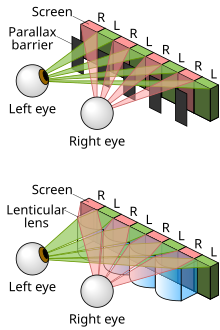
Back Autoestereoscòpia Catalan 3D fotografie Czech Autostereoskopie German Autoestereoscopia Spanish Autostéréoscopie French ऑटोस्टीरियोस्कोपी Hindi Autostereoscopia Italian 오토스테레오스코피 Korean Autostereoscopie Dutch Autostereoscopia Occitan

Autostereoscopy is any method of displaying stereoscopic images (adding binocular perception of 3D depth) without the use of special headgear, glasses, something that affects vision, or anything for eyes on the part of the viewer. Because headgear is not required, it is also called "glasses-free 3D" or "glassesless 3D".
There are two broad approaches currently used to accommodate motion parallax and wider viewing angles: eye-tracking, and multiple views so that the display does not need to sense where the viewer's eyes are located.[1] Examples of autostereoscopic displays technology include lenticular lens, parallax barrier, and integral imaging. Volumetric and holographic displays are also autostereoscopic, as they produce a different image to each eye,[2] although some do make a distinction between those types of displays that create a vergence-accommodation conflict and those that do not.[3]
Autostereoscopic displays based on parallax barrier and lenticular methodologies have been known for about 100 years.[4]
- ^ Dodgson, N.A. (August 2005). "Autostereoscopic 3D Displays". IEEE Computer. 38 (8): 31–36. doi:10.1109/MC.2005.252. ISSN 0018-9162. S2CID 34507707.
- ^ Holliman, N. S., Dodgson, N. A., Favalora, G. E., & Pockett, L. (2011). Three-dimensional displays: a review and applications analysis. IEEE transactions on Broadcasting 57(2), 362-371.
- ^ "Resolving the Vergence-Accommodation Conflict in Head-Mounted Displays" (PDF). 22 September 2022. Archived from the original (PDF) on 22 September 2022. Retrieved 22 September 2022.
- ^ "Autostereoscopic display". XVRWiki. 1 December 2013. Retrieved 6 October 2024.